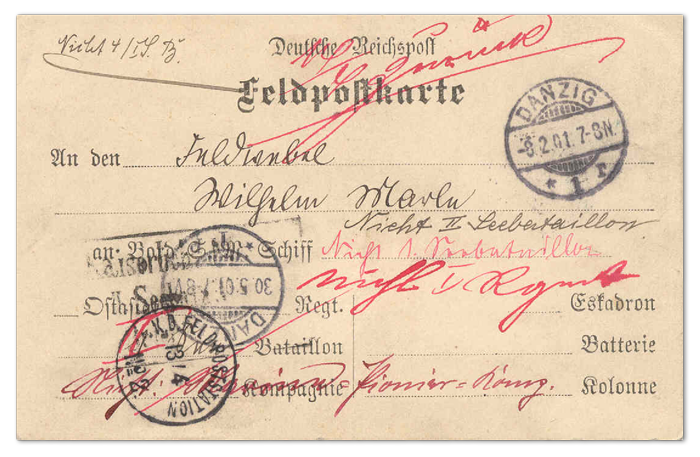The message from Danzig on the back of this card is a simple enquiry: why has it been so long since we have heard any news from you? The writer’s anxiety may well have been heightened when the card came back over three months later as the addressee could not be traced.
Collection: G du B
The Fieldpost card was simply addressed to Feldwebel Wilhelm Marle, 1 See Bataillon (the “1 See” in front of the printed word ‘Bataillon’ having been subsequently obscured by the Feldpost arrival, and Danzig return postmarks). That short address was all that was necessary to direct the card to China.
In May 1900 as a result of the ‘Boxer rebellion’ erupting in the Chinese province of Pechili, the guards at the German embassy in Peking had been strengthened by a contingent of fifty German marines of the Third Naval battalion but on 20 June the German Ambassador was murdered. A large international force was despatched to China in June/July including two formations of troops from Germany: (i) the German ‘Marine Expeditionary Corps’ consisting of the First and Second Sea Battalions, totalling approximately 2,500 men, and (ii) the ‘East Asia Expeditionary Force’ comprising 577 army officers and 11,213 men, reinforced in August and September by a further 289 officers and 7,565 men. The ‘Boxer’ insurgents were gradually cleared and at the end of May 1901 peace terms were agreed leading to the gradual withdrawal of foreign troops between June and September 1901.
The card was posted in Danzig on 8 February 1901 and arrived in China on 13 April. The German ‘K.D. FELDPOSTSTATION No. 2’ postmark was used in Peking from 11 September 1900 to 31 August 1901. During the ‘Boxer rebellion’ mail to and from German troops was forwarded either through the civilian or the military mail. The sixty five days’ journey time and lack of civilian post arrival marks indicate that the card was sent by a slow naval transport from Germany via the Suez Canal.
The hunt through lists for sergeant Marle then began, as evidenced by the red and black ink disclaimers in different hands: Nicht II Seebataillon, Nicht 1. Seebataillon, Nicht Marine-Pionier-Komp., Nicht 4/I S.B. There is also a partial strike of a boxed handstamp (possibly three line Kaiserliche…See…B…) which may either be a naval post forwarding endorsement or a unit stamp. After a day’s search (long enough under wartime conditions to devote to the task) the card was marked in red, seemingly with an exasperated flourish, 14/4 Zurück. The journey home for the card was rather shorter, just forty seven days to Danzig where it arrived on 30 May.
Given the number of German troops deployed in support of the China Campaign, the complicated logistics involved in getting them to station and the urgent and sometimes heavy fighting involved, it is perhaps not surprising that the card did not reach its intended addressee.
Sources:
Albert Friedemann, The Stamps and Cancels of the German Colonies and the German Post Offices Abroad – German Post in China, various translators, published Germany & Colonies Philatelic Society, 1984
Korv. Kapt. A.D. Fr. Crüsemann, Deutsche Marine-Schiffspost, translated Walter Scheck, published Germany & Colonies Philatelic Society, 1980.
* * * * *
The above article appeared in The Danzig Philatelist No. 4 Oct-Dec 2007 – the journal of the Danzig Study Group of the UK
Annual Subscription: UK: £10.00.
Cash or sterling cheques payable to ‘P.G.H. du Boulay’
Non-UK: Europe £12.00, Rest of World £15.00.
Cash only in sterling or equivalent in Euros, Polish Złoties or US Dollars
Giles du Boulay, 8 Malvern Road, Aylesbury, Bucks., HP20 1QF, UK
Tel.
See page on www.Danzig.org – the website for Danzig Philately.
* * * * *








If you enjoy our articles, please like us on Facebook and recommend us on your favourite social media…